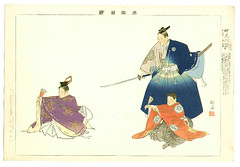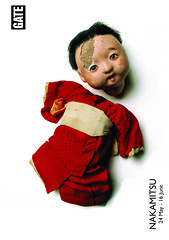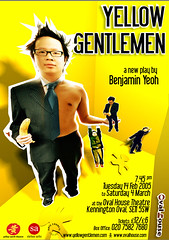Sustained theatre & underfunding
This report here makes interesting reading. It is the result of the “Sustained Theatre” consultation in to funding for the non-white sector – perhaps one could call it “black” or “BME” or “minority” but those are all unsatisfactory labels.
I found this part telling:
“… substantial amounts of capital funding over the past 10 years that
have been made available to white mainstream organisations, but not to the
extent it could and should have done for theatre practitioners in The Sector.
The Arts Council had to review radically its approach to distributing Capital
Lottery funds when it emerged that less than 1 per cent of grants allocated across
all artforms had been awarded to arts organisations led by groups categorised
as ‘culturally diverse’. Strategies were developed to address this situation and
these began to bear fruit in the following round of bids – and the percentage rose
to just over 32 per cent.
From 1996 to 2005, the funds allocated by the Arts Council across all artforms
to ‘culturally diverse’ organisations for capital expenditure was £41,739,923. The
total funds allocated during the same period were £994,814,057.
Although it is fair to say that there has been some increase in the number of
Sector-led arts organisations gaining Arts Council financial support, an examination
of the figures for regularly funded organisations, which is at 4.4 per cent for
years 2005/06, demonstrates the extent to which The Sector is still substantially
under-resourced.”
The Sector should have funding to about the tune of 8 to 9% if it were to reflect the UK population.
In London, this figure would be closer to 30%.
Taking the UK stats, this would suggest that the non-white theatre sector has been underfunded to the tune of about £5m a year for the past 10 years ie £50m.
Now Arts funding is already – arguably – underfunded (I say arguably because there’s only so much money to go round health, education, guns etc.) so this make non-white arts doubly underfunded.
If this were a research and development company or any company which needs capital expenditure to grow – this act of underfunding would probably leave it dead in the water.
Draw your own conclusions.
Rufus Norris & David Eldridge & money
Guardian interview Norris and Eldridge.
I’ve had the fortune to be in work shops with both of them (not at the same time!).
One of the most useful practical notes that Rufus gave aspiring directors was along the lines of:
“… you’re unlikely to make money… I never started to really make any money until I was 40… before that I probably never earned more than about 10k in any one year… the thing to do is find somewhere cheap or even free to live, once you have your living sorted you can get by and you can concentrate on your work… but if you are having to constantly try and pay the rent and keep body and soul together, it’s very hard to go out there and do the work you want to do…”
That really hit a note with me. You can say many things about people with inheritance money or trust funds, but if they get it right, the money buys them the freedom to do the work they want to do and perhaps that is one of the reason why privileged children go on to make a name for themselves, it may be contacts and money but it may simply be the work they do – they can afford to do the work they are passionate about.
I don’t think it’s necessarily a bad things for the arts but it’s worth thinking about if you don’t come from a background of money, you still have to keep up with the work you really want to do and feel passionate about because if you’re always jobbing it is so much harder to create stand out pieces.
OK. Back to the day job.
Raines
I must admit to feeling some how slightly jealous of Nina Raine and Moses Raine. Both have plays on in London at the moment. They are both children of poet Craig Raine – 21-year-old son Moses with Shrieks of Laughter at Soho Theatre and 30-year-old daughter Nina’s Rabbit at the Old Red Lion. Does this happen much? It certainly helps publicity.
Still, I wonder what it really is like to have a brother / sister both writing plays?
According to Mark Shenton the list of thank yous for Rabbit… “stretches from Nicholas Hytner and Tom Stoppard to Michael Frayn, Claire Tomalin, Ian McEwan, Salman Rushdie, David Hare and Parick Marber, and even Gillian Anderson, Kathy Burke and Anne Robinson.” So Nina is certainly well connected and advised.
I haven’t managed to see the plays yet, so I reserve judgment, although the reviews have been generally positive.
Craig, Moses and Nina have also all written for Arete, which Craig edits.
Nina has written some intriguing pieces for Arete. I particularly like the one comparing Stephen Daldry’s version of Caryl Churchill’s A Number to Peter Brook’s version. See here. I only saw Brook’s versions so again can not really comment, but Nina did work quite closely with the Daldry version and this may inform her comparative review – still it is informative about how two unquestionable great living directors take on one of our greatest living playwrights.
It is also fascinating for me because my adaptation for Nakamitsu only runs for about 12 pages and A Number only runs for about 19 pages or so. Thus it is instructive on how to direct short plays….
Her conversations with Peter Gill also worth reading.
Red Room seeks new Artistic Director
Lisa Goldman is heading to the Soho so she is asking to spread the word that:
The Red Room is seeking a new Artistic Director to take forward our radical vision for new work.
The company is in great shape. We have recently appointed our first full
time producer, Ana Gillespie (formerly Lyrc Hammersmith), enabling the new Artistic Director to solely focus on artistic work. The part-time post allows for continuation of a
freelance career. We are an RFO with funding secured until 2008 and the new
AD will inherit a great international project we’ve been developing,
involving 6 countries.
Ad here
http://jobs.guardian.co.uk/browse/arts-and-heritage/theatre/vacancy-1142547.
html
Radiohead & Night-Light
Pages of new radio play creeping by ever so slow. Still it is creeping by.
Went to a Radiohead gig last week. My first. It was an all time best gig. It consistently reached places that theatre dreams to do and rarely consistently does. Radiohead reaches thoses places. Thom Yorke’s little shakes and tiny spin dances – yes I fall for such passion – and of course the music, the sound, the lights, the performances….
We talk of commitment. Commitment to a role or place or performance. Radiohead personify commitment and performance, which if I saw in every play I watched would leave me blown away.
Go see Radiohead with someone you love, or want to love.
Of course, I say all time best gig. But events are wrapped up in time and place. It equals a gig I saw in 1999, Cambridge. Lamb (Gorecki – a top falling in love song –
if i should die this very moment
i wouldn’t fear
for i’ve never known completeness
like being here
wrapped in the warmth of you
loving every breath of you
still my heart this moment
or it might burst )
Listen here
The Junction, a small venue and with Gorecki, spine tingles…. I thought I might have been in love, I was in the midst of finals nightmares and my Dad was dying.
Last week, I wasn’t with the girl I’d like to marry – she for convulated business reasons was in Hamburg (WHAT?! I know) – but with one of my long time best friends, known from the age of 7 and I don’t have any exams to do. So, Radiohead was probably the better gig.
Speaking of commitment to performances, I saw Night-Light at the Oval House theatre (until June 3 at Oval then touring) last week by Out of Inc.. Stephen Sharkey wrote the script (and his blog has his thoughts), but the physicality and totality of the performances were as important if not more so than the words.
Both performers were extremely committed. One yard stick to judge a performance (and I use several depending on mood!) is whether one falls slightly in love with the performers. In the moment, I think, I did (and I don’t think I’ve turned into dirty old man yet- I’m still in my 20s!).
Particularly, Camille Litalien who is teaser, rope dancer, spider and exudes playful intimacy. You want to touch her physicality, dance her dance, hang from her rope…. You feel sorry for Sinead Rushe, would-be sleeper – harassed by her shadow-self.
Unless you concentrate very hard, the non-linear story will probably wrap around you in fuzzy confusion but that is to miss the alternative language of light, sound, rhythm, dance and poetry being evoked. Strong images across all the media, often combining to create a powerful whole.
Still, if you like a straightforward story or even esoteric dance, this might not be for you. However, if you want to fall a little in love and be absorbed by a succession of images interweaving with snatches of dream story, then this is perfect.
Camille, Je voudrais un verre de vin rouge avec vous…. Non. Actually, I’ve found my soul mate already but yes passion and commitment whether from Thom or Camille is seductive to our soul. Just ask everyone at the Hammersmith Apollo last week.
Nakamitsu
Unexpectedly, I have been short listed (see below) for an adaptation/translation of the Noh play, Nakamitsu.
Noh – traditionally – would be considered very stylised by Western theatre standards. The costumes are amazing in their own right.
Here is a wood block scene (scenes for Noh theatre are popular material for some Japanese print makers) from the play.
And yes, it involves a beheading, duty and sacrifice.
Gawd. Shortlisted for Gate translation award!
Amazingly, I have been shortlisted for the Gate Translation award, for my interpretation of a Noh play, Nakamitsu. Gawd! Shortlist of 6 from over 70 entries, supposedly.
“I am extremely happy to inform you that NAKAMITSU has been shortlisted for the award. The standard of submissions was very high, so congratulations for making the shortlist of six plays.
Here are a few comments from their reports which may be of interest to you:
The world of ancient Japan is clearly evoked through the formal language and the thematic sense of obligation and hierarchy.
Although this play belongs to a canon of work for the Noh stage and is thus difficult to remove from its formal context, it does have resonance with today’s world in its themes.
The translator brings out the tone and feel of Japanese Noh Theatre but makes the piece work by its own merits.”
I am surprised for several reasons but mainly: 1. There is strong competition. 2. Noh plays are short.
Still, it is great news. I’ve also heard that Simon (or more properly Chi Kuen Simon Wu) has been short listed for, Wolf in the House, which is a Chinese play. So, it’s great news for Asian theatre as well.
However the Gate has shown up a slight misunderstanding of Chinese by suggesting there have been translations from “the Mandarin, Japanese, Krio and Chinese.”
Speakers of different varieties of Chinese all use one formal standard written language, athough in modern times this written language is itself based on one variety of spoken Chinese, Mandarin. (In pre-20th Century China Classical Chinese was used.) So unless the translation was from an oral tradition (possible) a written translation of Chinese or “Mandarin” is effectively the same.
Krio is (according to wiki) a creole language native to the Krios, a community of about 250,000 descendants of freed slaves living in Sierra Leone’s capital city of Freetown. It is also spoken as a lingua franca, or second language, by about 4 million Sierra Leoneans of other ethnic groups, and by thousands of Krio descendants living in other parts of West Africa. Although it is also a Dayak language from Indonesia/Borneo.
An Experiment of and under Theatrical Conditions
At the Soho Theatre last night for “An Experiment of and under Theatrical Conditions” please see the blog for it here.
It was part of Soho’s launch pad season and was very worth while seeing. It had a touch of ROAR about it, the “scratch” nights that Tassos Stevens and others created and curated. Further thoughts later, but one particular piece was very well received and that was the audience feedback clapping, in order to try and lead Greg McLaren in to performing an act (a press up) that he had no clue of before entering the room. I do think you need an engaged audience to make this type of theatre/science work.
Looking forward to Night-light at the Oval House, Stephen Sharkey has scripted it for Out of Inc.
Motor Town by Simon Stephens
Motortown by Simon Stephens
At the Royal Court, until May 20. Box office: 020 7565 5000
Directed by Ramin Gray with Hannah Eidinow assisting
I am still gathering my thoughts at the ideas behind Motortown.
It was very honest. It has some powerful scenes. The main character Danny and his brother were particularly compelling. However I felt that the play was slightly incoherent, slightly disjointed that the rules of Danny’s world did not quite connect together. Powerful and extraordinary but still disjointed. Then again the same could be said of Hamlet. Or time.
Having said that I would definitely recommend seeing it. The acting and production is superb, although I have some thoughts about it. See Lyn Gardner’s review here.
So rather than dissect why I felt the play was disjointed and I am going to talk about:
dancing chairs,
colour,
light,
Brecht,
space and boxing.
The honesty of the play was reflected in its directing. Actors are seen warming up on stage, with stage manager and backstage visible. We know this is a play. Brecht (amongst others was keen on this). How staged was this warming up? Perhaps some of it felt more for show than for real honesty of process. I am unsure. We catch our first glance of dancing chairs.
The lights are a large array suspended above a marked out rectangular space, with one huge directed floodlight on a bar at the back, which can riase and lower to change the timbre of the lighting. I notice this by about scene 2.
The space is like a boxing ring. Danny, the main character, fights either phyicall or verbally with lamost everyone he meets. They circle each other in this ring surrounded sometimes by nothing, sometimes by many cheap blue plastic chairs. The characters never leave th rectangle, they cower in the corner, they roam the pace, they meet, they part. The direction of the bouts appear honest within these rules.
Objects have a colour. Blood wiped away. Green petrol cans. Blue chairs. White light. Colour defines.
Scene changes are punctuated by choreographed movement of chairs between the actors. This gives the scene changes and play a consistency of form and movement. It also enables each scene to start in a very specific and defined way. When done well, it also helps the energy to carry from one scene to the next and involves all the actors in the manner of a holistic company. However, the dancing of the chairs seems arbitrary. Perhaps pretty to look at. But despite the benefits of linking with a movement of chairs, is it over-elaboration which subtracts from the clear delineation of the rest of the play?
Dancing is to walking as
Poetry is to talking
But does it help the music and the rhythm of the play?
Google trends
Is this the future of data mining ? Of mining for out intentions?
It suggests that “theater” is a more popular search in Minneapolis than New York, next Chicago.
And also the “theatre” is more popular search in Thames Ditton than London! but for “fringe theatre” Edomonton (Canada), Dublin and Edinburgh are the places where people are looking….
Look Back in Anger
Billington captures a night of tribute at the Court.
Osborne is “our poet laureate of lost opportunity, of missed connections and of hidden dread, of what he himself calls the comfortless tragedy of isolated hearts”. [David Hare]
Frayn and procrastinating
I have an impending deadline in early June for the first draft of my World Service radio play. Thus I am prevaricating by reading children’s book. This weekend it was The Lionboy trilogy.
I’ve managed to stay away from blogging to try and write but books have got the better of me. Lionboy was good, however I did felt the authors were increasingly inventing “devices” to help them out which were not necessarily organically driven out of the story eg the all speaking, all translating chameleon (who is great) but kind of appears from no where. Still, not a real gripe.
Didn’t get on to the Paines Plough writing group, but they did seem to like the play some what. Obviously, not enough.
Finally, have enjoyed reading this about Michael Frayn – here – I’d like to be able to write in a nice study in Richmond.


